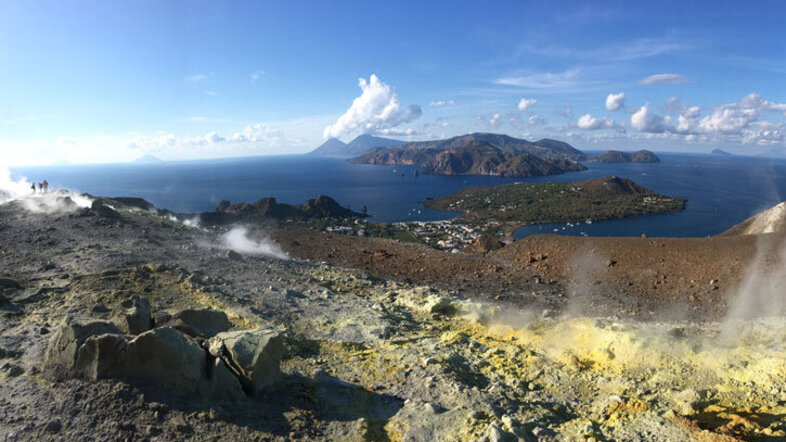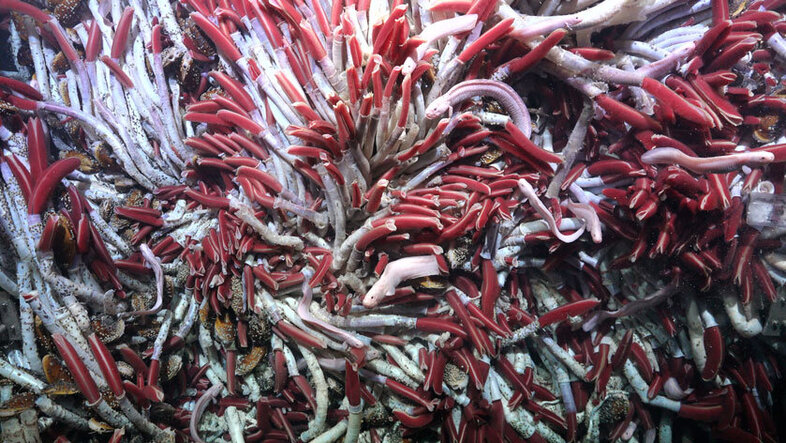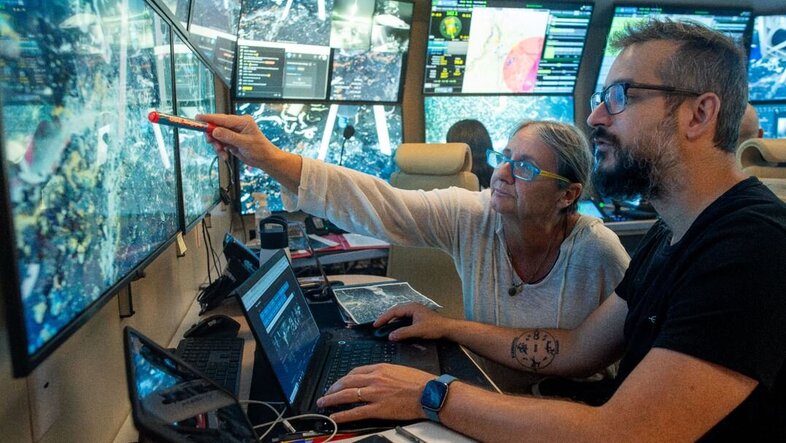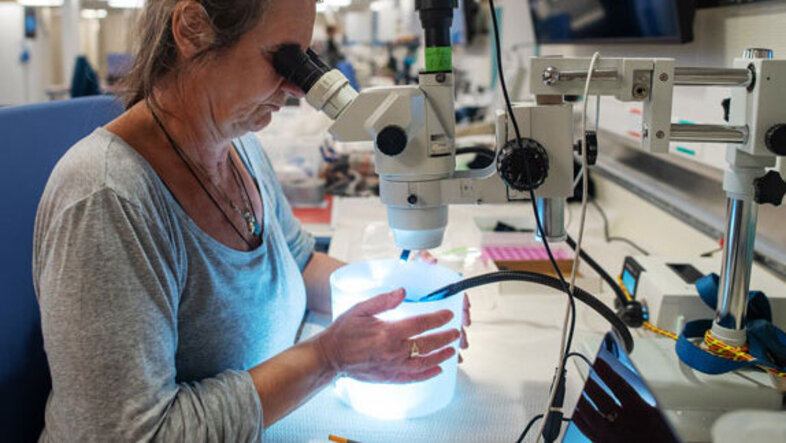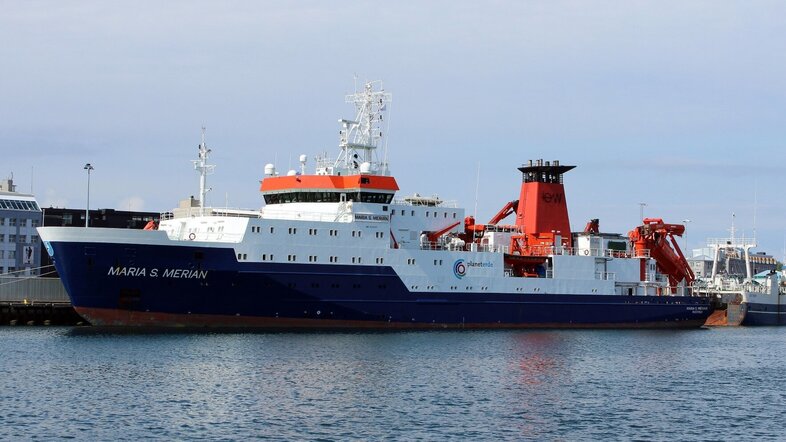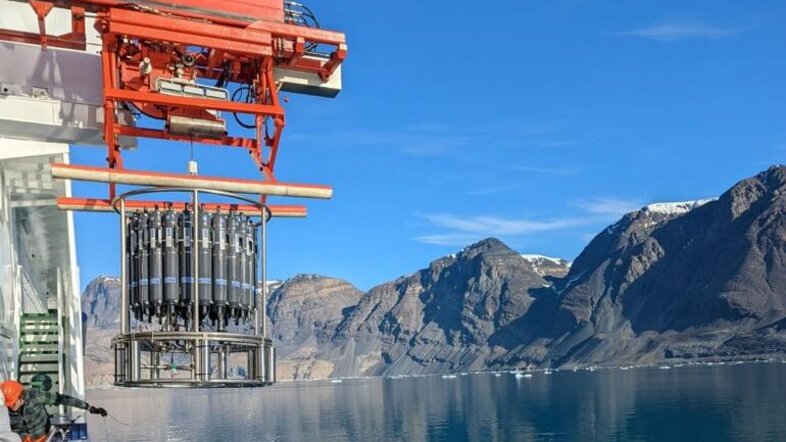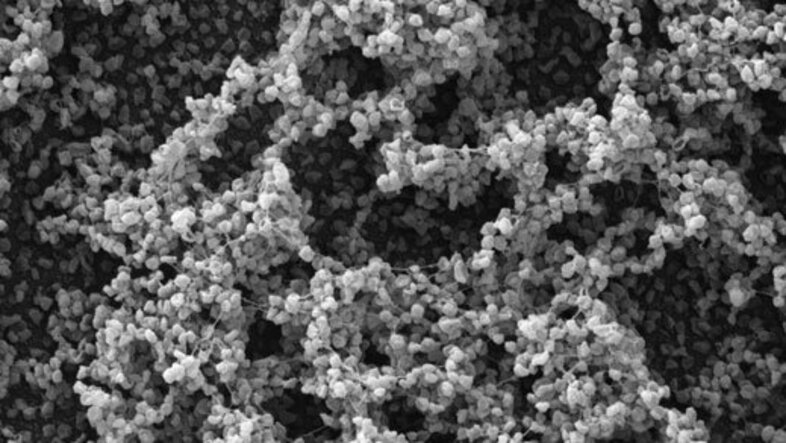Thriving at the limits of life
The East Pacific Rise, 2,500 metres below the surface of the sea, is clouded in eternal darkness. Here, the pressure is so high that submarines made of steel and featuring centimetre-thick windows would implode if only one screw loosened. The water temperature is just above freezing – unless submarine volcanoes bring it to boiling temperature. And still: the deep-sea giant tube worm feels on top of the world here.
Riftia pachyptila, as the deep-sea dweller is known by scientists, requires neither sun nor organic food to survive. Symbiotic bacteria living in it supply the worm with nutrients using the sulphurous volcanic water.
The "suburbs" of the submarine volcano
The slopes of submarine volcanoes along the East Pacific Rise are densely populated with colonies of these giant tube worms. But the dream team of tube worm and sulphur-eating bacteria probe into even more extreme habitats. Monika Bright, marine biologist at the University of Vienna and her team were quite surprised when they dared to take a glimpse beneath the volcano as the first scientists worldwide – not an easy endeavour at 2,500 metres beneath the ocean. The underground system of cavities at the periphery of the volcano – Bright describes this area as "the suburbs" – is hustling and bustling with giant tube worms. This is the first evidence of living animals below the ocean floor.
The discovery enabled the expert on deep-sea habitats to finally solve a mystery that had been puzzling her for a long time, “The larvae of the Riftia are so-called pioneer species. They are one of the first species to colonise a newly formed submarine volcano. I have always been wondering how they actually got to this place. I had the idea that they actually did not come from the open ocean but rather from below. Most of my colleagues thought I had gone mad,” Bright explains her hypothesis, laughing.

Environment and Climate Research Hub (ECH)
Christa Schleper and Gerhard Herndl are members of the Environment and Climate Research Hub (ECH), the new multidisciplinary research network within the University of Vienna. It is dedicated to connecting researchers addressing environment, climate, and sustainability from different academic viewpoints. More about the objectives of the network.
Currently, the ECH has 65 members from different faculties and departments of the University of Vienna. All of them carry out research in the field of environment and climate.
How is it possible that these creatures do not only colonise the underground system of cavities but apparently also thrive there? Monika Bright explains the astonishing process, “The volcano itself is the reason why the larvae come from below.” The crater continuously fires off hot water which rises upwards. The larvae are not able to swim against this current to approach the volcano from the open waters. But the suction effect pulls water into the volcanic cone through the surrounding porous basalt. The water heats up and is enriched with sulphur and other substances. Together with the water, a wide range of particles reach the hollows in the cooled once-molten magma – including the larvae of the tube worm. In the extensive system of magma hollows below the surface of the volcano, they find moderate temperatures and sulphurous water which the bacteria providing their nutrition need.
“We have measured the conditions in these hollows, such as water temperature and the hydrogen sulphide concentration, and have discovered that they are well within the limits of the conditions that tube worms usually need to survive,” says Bright. “So, the deep-sea giant tube worms are just as comfortable within the volcano as on its surface. From the perspective of the worm, the hollow does not differ much from the surface.”
“Extreme is a question of perspective,”
confirms Monika Bright’s colleague Gerhard Herndl, emeritus professor of Microbial Oceanography at the University of Vienna: “All species have a certain tolerance range within which they can survive. For some, this range is quite wide, while for others, such as us humans, it is rather narrow.”
So, the comfort zone of others might just begin in a place that we find extreme. Gerhard Herndl is investigating global cycles and microbial communities in the open ocean and has been awarded the Wittgenstein Award for his research in 2011. He adds that the majority of microorganisms in the sea must have a very wide tolerance range. Most of these microorganisms are not able to move at all or only to a very limited extent. They use the strong ocean currents, sink down and rise again. They have to cope with varying temperatures, water pressures and nutrient and pollutant concentrations and adapt to these conditions. The microorganisms can survive large fluctuations, but they do not cope equally well everywhere. For example, if the currents catapult them from warm tropical waters to the Arctic deep sea, the metabolic activity of many species decreases. “These findings are important, for example, for making predictions about nutrient production and consumption and thus also about climate change,” explains Herndl.
Our extreme past
3.5 million years ago, all conditions on Earth were extreme – by human standards. Besides bacteria, a domain of organisms was spreading on the recently cooled planet whose representatives are still considered the survivalists par excellence today: Archaea. Some of these fascinating microorganisms are living in hot sulphur springs, others in extremely acid, alkaline or saline water bodies, bearing high pressures or even radioactive radiation. The "hottest" organisms were isolated from the deep sea and are still able to divide at temperatures of 122°C. “The archaea can teach us about the physical boundaries of life on Earth as we know it,” says Christa Schleper, who conducts microbial ecosystem research at the University of Vienna. The 2022 Wittgenstein Award laureate has been investigating archaea throughout her entire academic career.
Archaea have developed their own strategies to conquer extreme niches, distinguishing them from other domains of life. Their entire inner life is adapted to the often extreme niche. For example, heat-loving (thermophilic) species have more compact proteins and can thus sustain higher temperatures.
What makes archaea so special?
Archaea differ fundamentally from bacteria and eukaryotes, both with regard to their genetic disposition and with regard to their biochemistry. Even though they are protozoa like bacteria, unlike bacteria and eukaryotes they have a completely different outer membrane that contains lipids (fats) linked with ether bonds instead of esters, which – among other things – enables them to survive in extreme conditions. Like bacteria, their genome is free in the cell and it is ring-shaped, but they also share certain genetic features with eukaryotes, particularly in the machinery for replication, transcription and translation. The combination of these unique features makes archaea a distinct domain of life. Recent research points to a lineage of eukaryotes from archaea or to a common ancestor of the two domains.
Archaea occupy even the most hostile habitats on this planet, but for the small survivalists, the extreme conditions are not even extreme. “Same as all organisms, archaea are pushed into certain niches by the evolutionary pressures and they have certain characteristics that allow them to occupy extreme niches. They feel comfortable in their habitat and I do not really have to admire them for it,” says Schleper smiling.
Extremes and us
Nevertheless, we still admire the tiny and giant survivalists a wee bit. What can we learn from tube worms, marine bacteria and extremophile archaea? Why is it important to investigate the boundaries of life and our own origins?
“The term ‘extreme’ is an anthropocentric one,” says Gerhard Herndl. Us humans have a very narrow comfort zone, so it can be helpful for us to see the world from their perspective and thus through different eyes. For example, we can learn something special about the value of cooperation on the example of extremophile organisms. Only the symbiosis between sulphur-eating bacteria and tube worms allows them to settle on submarine volcanoes and fill otherwise inhabitable hollows with life.
“Countless types of symbiosis and mutualism exist on our planet. Cooperation can sometimes enable organisms to get further than fending for themselves,” confirms Christa Schleper. The fact that cooperation is in most cases useful could also be a lesson for the researchers themselves. Monika Bright explains this on the example of the discovery of the new underground habitat, “Geologists have described the hollows underneath the volcanoes already a long time ago but they did not watch out for any animals living there. Us biologists, on the other hand, have not taken their research into account enough. We could have made our discovery much sooner, had there been more cooperation.”
The fabulous world of Riftia pachyptila
Deep-sea giant tube worms lead a surprisingly diverse life. As soon as they have found a nice place near an active sulphuric submarine volcano, they settle in the basaltic rock. At this stage, they still have a digestive system and feed themselves. As soon as they have passed from the mobile to the immobile phase, they are colonised by their symbionts – via the skin. The bacteria living in symbiosis with Riftia fixate carbon from carbon dioxide with the help of hydrogen sulphide. This type of photosynthesis without any light – chemosynthesis – is what actually enables the life of tube worm colonies in eternal darkness. Once the bacteria have settled in the immobile worm, the worm loses its mouth as well as its digestive system and is thus entirely dependent on the symbiont living inside of it. In return, the worm is a safe place for the bacteria and provides the colony with fresh sulphurous water through its plumes. This successful cooperation with the sulphur-eating bacteria makes the tube worm one of the fastest growing invertebrates on Earth. It can reach a length of up to two metres and grows more than one meter in its first year of life alone.
In various research projects in Germany and the US, including at Pennsylvania State University and the Rosenstiel School of Marine and Atmospheric Science in Miami, and as a professor at the University of Vienna, she was involved in 15 research expeditions to deep-sea hydrothermal vents in the Pacific, the Gulf of Mexico and the Antarctic.
He has been awarded numerous prizes and awards, including the Euroceans Roland Wollast Award for Scientific Achievements in Marine Science in Europe, the Wittgenstein Award and in 2014 the G.E. Hutchinson Award of the Association for the Sciences of Limnology and Oceanography (ASLO). He has been a full member of the Austrian Academy of Sciences since 2013. He is a member of the Environment and Climate Research Hub.
She studied biology in Aachen and Konstanz. She completed her doctorate at the Max-Planck Institute of Biochemistry in Munich and worked as a researcher and teacher in the US, Norway and Germany. Furthermore, Christa Schleper is a member of the American Society for Microbiology and member of the Austrian Academy of Sciences. She was awarded the Wittgenstein Award in 2022. She is a member of the Environment and Climate Research Hub.
